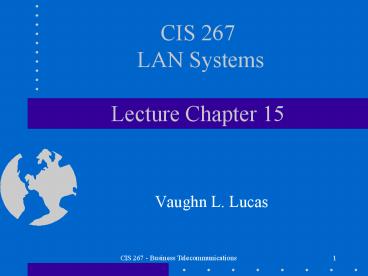CIS 267 LAN Systems Lecture Chapter 15 PowerPoint PPT Presentation
1 / 24
Title: CIS 267 LAN Systems Lecture Chapter 15
1
CIS 267 LAN SystemsLecture Chapter 15
- Vaughn L. Lucas
2
High-Speed LANs
- Why?
- Extraordinary growth in speed, power, and storage
capacity of PCs - Increasing use of LANs as computing platforms
- Examples
- Server farms
- Workgroups with power requirements
- High-speed backbones
3
Traditional Ethernet
- Ethernet and CSMA/CD (IEEE 802.3)
- Carrier sense multiple access with collision
detection - Four step procedure
- If medium is idle, transmit
- If medium is busy, listen until idle and then
transmit - If collision is detected, cease transmitting
- After a collision, wait a random amount of time
before retransmitting
4
802.3 Medium Notation
- Notation formatltdata rate in Mbpsgtltsignaling
methodgtltmaximum segment length in hundreds of
metersgt - e.g 10Base5 provides 10Mbps baseband, up to 500
meters - T and F are used in place of segment length for
twisted pair and fiber
5
802.3 10BaseX Media Options
6
Fast Ethernet (100Mbps)
- Easy to integrate with existing systems
- Can use UTP (-TX) or fiber (-FX)
- Uses star-wired topology, using a central
multiport repeater (broadcast method) - If NICs support full-duplex mode, switched hub
must be used
7
802.3 100Base-T Options
8
802.3 100BaseX Media Options
9
Example 100-Mbps Ethernet Backbone Strategy
10
Gigabit Ethernet
- Still under development
- Retains CSMA/CD protocol and Ethernet format,
ensuring smooth upgrade path - Uses optical fiber over short distances
- 1-gbps switching hub provides backbone
connectivity
11
Gigabit Ethernet Configuration
12
Gigabit Ethernet Media Options
13
Token Ring LANs (802.5)Medium Access Control
- Token seized by changing a bit on the
circulating frame to indicate start of frame
rather than token - Default configuration requires sender to complete
transmission and begin receiving transmitted
frame before releasing the token - Early token release allows release of token
after transmission but before receipt of frame
14
802.5 Transmission Media
- Original specified shielded twisted pair with
data rates of 4 and 16mbps - New addition to standard allows use of UTP for
4mbps - Utilizes differential Manchester encoding
- 1997 update to IEEE 802.5 introduced dedicated
token ring (DTR).
15
Token Ring Operation
16
Fibre Channel
- combine the best features of channel and
protocol-based technologies - the simplicity and speed of channel
communications - the flexibility and inter-connectivity that
characterize protocol-based network
communications. - more like a traditional circuit-switched or
packet-switched network, in contrast to the
typical shared-medium LAN
17
Fibre Channel Goals
- Full-duplex links with two fibers per link
- Performance from 100 Mbps to 800 Mbps on a single
link (200 Mbps to1600 Mbps per link) - Support for distances up to 10 km
- Small connectors
- High-capacity utilization with distance
insensitivity
- Greater connectivity than existing multidrop
channels - Broad availability (i.e., standard components)
- Support for multiple cost/performance levels,
from small systems to supercomputers - Ability to carry multiple existing interface
command sets for existing channel and network
protocols
18
Five Applications of Fibre Channel
- See Figure 15.9 on page 420 of text
19
Fibre Channel Elements
- Nodes
- The end systems
- Includes one or more N_ ports for interconnection
- Fabric
- Collection of switching elements s between
systems - Each element includes multiple F_ ports
- Responsible for buffering and for routing frames
between source and destination nodes
20
Fibre ChannelProtocol Architecture
- FC-0 Physical Media Includes optical fiber,
coaxial cable, and shielded twisted pair, based
on distance requirements - FC-1 Transmission Protocol Defines the signal
encoding scheme - FC-2 Framing Protocol Defines topologies, frame
format, flow/error control, and grouping of
frames - FC-3 Common Services Includes multicasting
- FC-4 Mapping Defines the mapping of various
channel and network protocols to Fibre Channel
21
Wireless LANS
- LAN extension
- Wireless network connected to a main wire-based
network - Cross-building interconnect
- Point-to-point link between networks in separate
buildings - Nomadic access
- Wireless link between a LAN hub and a mobile data
terminal - Ad hoc networks
- a peer-to-peer network (no centralized server)
set up temporarily to meet some immediate need.
22
Wireless LAN Requirements
- Throughput
- Number of nodes
- Connection to backbone LAN
- Service area
- Battery power consumption
- Transmission robustness and security
- Co-located network operation
- License-free operation
- Handoff/roaming
- Dynamic configuration
23
Multiple-Cell Wireless LAN
24
IEEE 802.11 Standards
- Association/Re-Association/Disassociation
- Authentication
- Privacy
- Physical Media
- Infrared at 1 or 2 Mbps at a wavelength of
850-950 nm - Direct-sequence spread spectrum in the 2.4-GHz
ISM band - Frequency-hopping spread spectrum in the 2.4-GHz
ISM band, at data rates of 1 and 2 Mbps.

